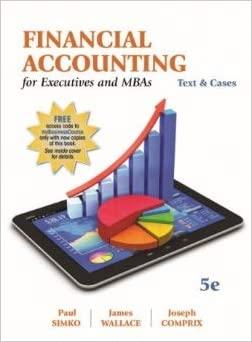Answered step by step
Verified Expert Solution
Question
1 Approved Answer
On January 1, 2017, the board of directors was considering the distribution of a $65,500 cash dividend. No dividends were paid during 2015 and 2016.



On January 1, 2017, the board of directors was considering the distribution of a $65,500 cash dividend. No dividends were paid during 2015 and 2016. Required: Determine the total and per-share amounts that would be paid to the common shareholders and to the preferred shareholders under two independent assumptions: 1-a. The preferred shares are non-cumulative. (Round your per share amount to 2 decimal places.) Total Per Share Paid to preferred shareholders Paid to common shareholders 1-b. The preferred shares are cumulative. (Round your per share amount to 2 decimal places.) Total Per Share Paid to preferred shareholders Paid to common shareholders 2. Why were the dividends per common share less for the second assumption? The total dividend amount and dividends per share of common shares were less under the second assumption because the dividend rate for preferred shareholders was increased. The total dividend amount and dividends per share of common shares were less under the second assumption because the dividends in arrears on the preferred shares had to be fulfilled before dividends could be paid for the current year. 3. What factors would cause a more favourable dividend for the common shareholders? (Select all that apply.) Answer is complete and correct. The preferred dividends were not in arreal The total dividend distribution was increased The preferred dividends were not cumulative The preferred dividends were in arrears The total dividend distribution was decreased On January 1, 2017, the board of directors was considering the distribution of a $65,500 cash dividend. No dividends were paid during 2015 and 2016. Required: Determine the total and per-share amounts that would be paid to the common shareholders and to the preferred shareholders under two independent assumptions: 1-a. The preferred shares are non-cumulative. (Round your per share amount to 2 decimal places.) Total Per Share Paid to preferred shareholders Paid to common shareholders 1-b. The preferred shares are cumulative. (Round your per share amount to 2 decimal places.) Total Per Share Paid to preferred shareholders Paid to common shareholders 2. Why were the dividends per common share less for the second assumption? The total dividend amount and dividends per share of common shares were less under the second assumption because the dividend rate for preferred shareholders was increased. The total dividend amount and dividends per share of common shares were less under the second assumption because the dividends in arrears on the preferred shares had to be fulfilled before dividends could be paid for the current year. 3. What factors would cause a more favourable dividend for the common shareholders? (Select all that apply.) Answer is complete and correct. The preferred dividends were not in arreal The total dividend distribution was increased The preferred dividends were not cumulative The preferred dividends were in arrears The total dividend distribution was decreased
Step by Step Solution
There are 3 Steps involved in it
Step: 1

Get Instant Access to Expert-Tailored Solutions
See step-by-step solutions with expert insights and AI powered tools for academic success
Step: 2

Step: 3

Ace Your Homework with AI
Get the answers you need in no time with our AI-driven, step-by-step assistance
Get Started


